Cervical Cancer
Self-Screening
Self-collection cervical cancer screening
A/Prof Michael Campion
From 1 July 2022, all women due for their 5-yearly cervical screening test (CST) were eligible for self-collection. The specimen is collected by introducing a small soft swab similar to the swabs used for COVID testing into the vagina.
The CST uses an HPV (Human papilloma virus) DNA test to detect the presence of cancer causing HPV in the cervix and vagina. The HPV test is more sensitive than the pap smear, so it can be performed less frequently. The CST is the only Medicare-funded routine cervical screening test and is available to women aged 25 years and over. Self-collected samples have been shown to be as accurate as clinician collected samples and are a good option for women who do not feel comfortable with a clinician collected sample.
Participation in the National Cervical Screening Program has fallen in Australia over the past 20 years and was severely impacted by the COVID pandemic. Over a million Australian women eligible for cervical screening are either under-screened or have never been screened. Only around five in 10 women participate in the National Cervical Screening Program (NCSP) at the recommended interval.
Participation at the recommended interval is lower in the Northern Territory, and in remote communities. Some of the groups who are under-screened include those who: (i) identify as Aboriginal and Torres Strait Islanders, (ii) are culturally and linguistically diverse, (iii) are socioeconomically disadvantaged, (iv) have experienced sexual assault, (v) have a disability, (vi) identify as lesbian or bisexual, or (vii) are trans men and gender diverse people with a cervix who do not identify as women.
Over 70 per cent of all cervical cancers occur in women who have never been screened or have participated in the screening program only occasionally. An Australian Department of Health report found that those offered HPV testing using self-collected vaginal samples were more than twice as likely to participate in cervical screening.
Incidence and mortality rates from cervical cancer are two and four times higher, respectively, for Aboriginal and Torres Strait Islander women compared with non-Indigenous women. Reports from Queensland, New South Wales and the Northern Territory indicate that between 33.5 and 42.2% of eligible indigenous women are being screened, compared to 55.7–59.1% of non-Indigenous women. It is anticipated that self-collection will significantly improve participation rates, and ultimately improve cervical cancer outcomes.
In order to maximise participation in the cervical screening program, collection of the sample can occur in any setting that the healthcare professional believes to be appropriate, including in the context of a telehealth consultation. When counselling the patient, clear information must be given about how to collect the sample. Clinic patients should be encouraged to collect a sample before they leave. The healthcare professional need not observe the patient collecting the sample unless this is the patient’s preference. The healthcare professional should also provide information about how the test results will be given. The pathology laboratory should deliver the results to the requesting doctor, who is responsible for informing patients of their results and any required follow-up.
Approximately 10% of self-collected samples will be positive for HPV. 2% will be positive for HPV 16/18, (the highest risk HPV types), and these patients should be referred directly for colposcopic examination of the cervix. The remaining 8% will be positive for non 16/18 HPV types. These patients need to return for a clinician collected sample for liquid-based cytology. If the cytology is negative, the patient should have a repeat HPV test in 12 months.
In the past, self-collected cervical screening programs have been attempted in a number of settings but have had problems because of poor follow-up of screen detected abnormalities. Over the past 3 months, I have overseen the establishment of Nurse-led self-collection for indigenous women in Clinics at Orange and Moree. The early experience has been extremely encouraging. Three precancerous cervical lesions have already been detected and treated among indigenous women who had never previously presented for screening.
Sources:
Cancer Council Australia. CERVICAL CANCER SCREENING; Self-collected vaginal samples
Who we are
We are the Australian Gynaecological Cancer Foundation. The only organisation that focuses on funding laboratory research into all eight gynae cancers.
Subscribe to our newsletter
Get in touch
Where to find us:
1/1 Jamison Street, Sydney NSW 2001
For general enquiries:
telephone: +61 2 8235 2606
email: [email protected]
Together, we’re giving women hope.
Donations of $2 or more are tax deductable in Australia.
ABN: 17 152 685 295

© Australian Gynaecological Cancer Foundation | Privacy Policy

